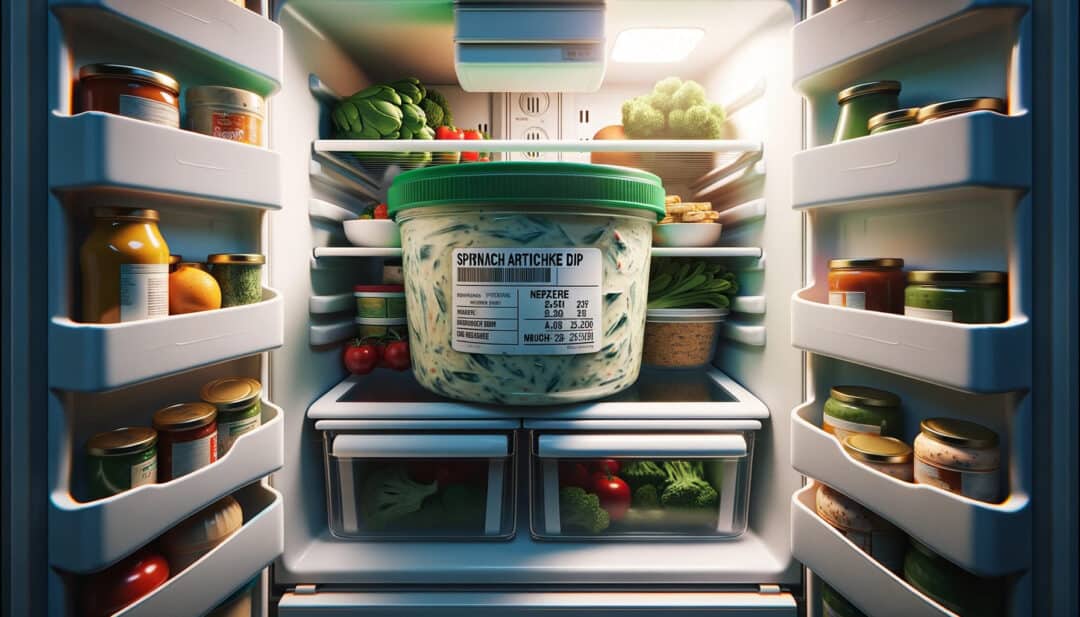How Long Does Spinach Artichoke Dip Last in the Fridge
Spinach artichoke dip holds a special place in the hearts of many across the United States. It’s the perfect appetizer for game day, New Year’s Eve, family gatherings, or any event. From the creamy dip served in a bread bowl to the cheesy dip with a hint of red pepper flakes, there’s a version for everyone.
But how long does spinach artichoke dip last in the fridge? Let’s delve into the delicious details.
The Basics of Storing Spinach Artichoke Dip:
- Duration: Good news! The homemade spinach dip, especially with fresh ingredients, can typically last 3-4 days in the fridge. However, some variations, especially those without much dairy, might stretch to 4-5 days.
- Sealed Container: Always store the leftover dip in a sealed container. This ensures it remains fresh and avoids absorbing other flavors from the fridge.
- Dairy-Based Consideration: For dairy-based dips, like those with mozzarella cheese and Greek yogurt, it’s crucial to ensure that they are kept cold. A cold dip will have a longer shelf life than one left at room temperature for extended periods.
- Excess Water: If you notice any excess water on top, it’s a good idea to place a paper towel over the dip before sealing the container. This will help absorb excess moisture, keeping the dip creamy and delightful.
Making the Best Spinach Artichoke Dip:

The best spinach artichoke dip recipe often includes creamy spinach, a can of artichoke hearts, mozzarella cheese, olive oil, black pepper, and sometimes a hint of red pepper flakes for those who like a little kick.
Some people prefer the easy spinach artichoke dip recipe using store-bought spinach dip as a base, while others swear by the baked spinach dip, which requires 20-25 minutes in a prepared baking dish.
Vegan spinach artichoke dip has become increasingly popular for those who love a twist. And for a classic touch, nothing beats the Knorr spinach dip recipe, one of the first recipes many of us tried.
Serving Suggestions:
Serve your delicious appetizer with pita chips, baguette slices, or fresh vegetables. If you want a twist, try serving it in a crock pot to keep it warm or even in a bread bowl for an extra touch of elegance. Pita bread lightly toasted with olive oil is also a favorite pairing for many.
Freezer Tips:
If you’ve made too much dip for your next party or want to prepare in advance, freezing is an option. For best results:
- Transfer the dip to a freezer-safe container or a resealable plastic bag.
- If using a disposable aluminum pan, cover with aluminum foil.
- Include freezer instructions on the container so you know the time frame for thawing and reheating.
- When ready to enjoy, thaw in the fridge and then reheat, ensuring the creamy consistency is maintained.
Factors Affecting the Longevity of Spinach Artichoke Dip in the Fridge
Ingredients and Shelf Life
The ingredients used in spinach artichoke dip, such as cream cheese, sour cream, shallots, and mayonnaise, can significantly impact its shelf life. Try this delicious spinach artichoke dip recipe!
Dairy products like cream cheese, sour cream, and mayonnaise have a limited lifespan. When making spinach dip, it is important to use fresh spinach and shallots for optimal flavor.
As a result, the overall longevity of spinach artichoke dip, especially when made with cheese and baked, can be affected by these perishable ingredients like comté.
Proper Storage Temperature
Keep your spinach artichoke dip fresh by storing it at the right temperature, below 40°F—this is especially important for dips with cheese, like comté.
Storing spinach dip and artichoke hearts in the fridge at a temperature below 40°F (4°C) helps inhibit bacterial growth and extends the shelf life of this spinach artichoke dip recipe.
Keeping your artichoke hearts dipping consistently cold ensures that harmful bacteria do not multiply rapidly, keeping your artichoke hearts dipping safe to consume for a longer period.
Contamination Risks

Contamination from double-dipping or using dirty utensils can shorten the lifespan of spinach artichoke dip. When people repeatedly dip chips or crackers into the dip, bacteria is introduced from their mouths into the container.
Similarly, using unclean utensils transfers bacteria onto the surface of the dip, increasing the risk of spoilage. To maximize the longevity of your spinach dip, it’s essential to practice good hygiene and avoid cross-contamination when making this dip recipe.
Proper Sealing and Packaging
Properly sealing and packaging your spinach artichoke dip is vital in maintaining its freshness. Air exposure can accelerate spoilage due to oxidation processes. Store your drop in an airtight container or cover it tightly with plastic wrap before placing it in the fridge.
This will help prevent air from entering and prolong the shelf life of your spinach dip or spinach artichoke dip recipe.
Guidelines for Storing Spinach Artichoke Dip in the Refrigerator
To ensure that your spinach artichoke dip stays fresh and delicious, follow these guidelines for storing it in the refrigerator:
Store in an Airtight Container
Using an airtight container is vital. This helps prevent moisture loss and maintains the quality of the dip. Transfer the dip into a clean and dry container before refrigerating it.
Keep at or Below 40°F (4°C)
It’s important to keep the spinach artichoke dip refrigerated at or below 40°F (4°C) to inhibit bacterial growth and maintain food safety. This temperature range helps preserve the ingredients’ freshness and extends the dip’s shelf life.
Avoid Strong-Smelling Foods
Avoid storing your spinach artichoke dip near strong-smelling foods to prevent flavor transfer. The flavors of pungent foods like onions or garlic can easily permeate through containers and affect the taste of your dip. It’s best to store the spinach dip recipe away from other dip recipes and ingredients.

Following these guidelines, you can ensure that your spinach artichoke dip stays fresh and tasty for as long as possible. Always use a clean container for storing spinach dip, keep it refrigerated at or below 40°F (4°C), and store it away from strong-smelling foods.
How Long Does Homemade Spinach Artichoke Dip Last?

Homemade spinach artichoke dip is a delicious and popular appetizer, but how long can you expect it to last in the fridge? Let’s dive into the shelf life of this tasty dip and some tips for storing it properly.
Homemade spinach artichoke dip typically lasts 3 to 5 days when stored properly in the refrigerator.
Freshness is key. After preparing or purchasing your dip, store it in an airtight container and place it in the refrigerator. This will help maintain the flavor of the spinach dip and prevent any potential spoilage.
Check for any signs of spoilage before consuming leftovers.
Before indulging in leftover spinach artichoke dip, always check for signs of spoilage. Discard the dip immediately if you notice any off odors or mold growth on the surface.
It’s better to be safe than sorry regarding food safety, especially when enjoying a delicious spinach dip!
Freezing homemade spinach artichoke dip can extend its shelf life by up to 3 months.
If you find yourself with more spinach artichoke dip than you can consume within a few days, freezing is a great option. Transfer the dip into freezer-safe containers or zip-top bags, removing as much air as possible.
Properly frozen spinach artichoke dip can last up to three months without compromising taste or quality.
To thaw frozen spinach artichoke dip, transfer it from the freezer to the refrigerator and let it defrost overnight. Once the spinach dip is thawed, please give it a good stir before reheating or serving cold.
Reheating Leftover Spinach Artichoke Dip: A Step-by-Step Guide
Reheating in the Microwave
To reheat leftover spinach artichoke dip, transfer it to a microwave-safe dish. Place the spinach dip dish in the microwave and heat it on medium power until warm. When reheating spinach dip, it’s crucial to stir occasionally to distribute heat and prevent hot spots evenly.
Reheating on the Stovetop
Alternatively, you can reheat the dip on the stovetop. Set your burner to low heat and place the dip in a saucepan or skillet. Stir the spinach dip continuously as you warm it up, ensuring it doesn’t stick to the bottom of the pan or scorch.
Other Methods for Reheating
If you prefer using an oven, preheat it to a low temperature (around 325°F or 160°C) when making spinach dip. Transfer the dip into an oven-proof dish and place it in the oven for 10-15 minutes or until heated.
For those who own a crockpot or slow cooker, transfer the dip into its removable insert and set it on low heat. Allow the spinach dip to warm up gradually over a couple of hours while stirring occasionally.
Remember, regardless of which method you choose, always keep an eye on your reheating process, especially when it comes to spinach dip. Overcooking can cause your dip to dry out or become rubbery.
Reheating leftover spinach artichoke dip is easy and convenient with these simple steps. Whether you use a microwave, stovetop, oven, or crockpot, ensure your dip is thoroughly heated before enjoying its creamy goodness again!
Making Spinach Artichoke Dip with Fresh or Frozen Spinach
Fresh and frozen spinach can both be used to make a delicious spinach artichoke dip. Here’s how you can incorporate each type of spinach into your recipe:
Fresh Spinach: Blanching and Chopping for Vibrant Flavor
To use fresh spinach in your dip, start by blanching it. Blanching involves boiling the spinach and immediately transferring it to an ice bath to stop cooking. This method helps retain the spinach’s vibrant green color while ensuring a fresh taste.
After blanching, chop the spinach finely before adding it to your dip mixture. This will help distribute the spinach dip flavors evenly throughout the dish. Fresh baby spinach works particularly well in this recipe due to its tender leaves and mild taste.
Frozen Spinach: Thawing and Squeezing Out Excess Moisture
If you’re using frozen spinach, thaw it completely before incorporating it into your dip. You can defrost the spinach dip by leaving it in the refrigerator overnight or microwave.
Once thawed, squeeze out any excess moisture from the frozen spinach. This step is crucial as excess moisture can make your dip watery. Use a clean kitchen paper towel to press down on the thawed spinach and remove as much liquid as possible.
Interchangeability of Fresh and Frozen Spinach
The great thing about making spinach artichoke dip is that fresh and frozen spinach can be used interchangeably, depending on your availability. The key is adjusting for moisture content – blanching fresh spinach removes some moisture while squeezing excess liquid from frozen spinach ensures proper consistency.
Whether fresh or frozen, incorporating flavorful ingredients like artichoke hearts, cream cheese, parmesan cheese, and mozzarella will result in a creamy and irresistible warm dip that pairs perfectly with tortilla chips, bread, or veggies.
Maximizing Enjoyment and Safety of Spinach Artichoke Dip
By understanding these aspects, you can ensure that your spinach artichoke dip stays delicious and safe to consume.
Remember to follow proper storage guidelines to maximize your enjoyment and safety when making spinach dip. This includes using airtight containers for storing spinach dip, keeping it at a consistent temperature of 40°F (4°C) or below, and consuming spinach dip within the recommended timeframe.
By avoiding any potential risks associated with food spoilage, you can enjoy the delicious taste of spinach dip without any worries.
FAQs – How Long Does Spinach Artichoke Dip Last in the Fridge?
How do I know if my spinach artichoke dip has gone bad?
👉 You can tell if your spinach artichoke dip has gone bad if it has an off smell, an unusual appearance such as discolored splotches or mold, and an off taste. If any of these signs are present, it’s best to discard the dip [7].
Can I freeze leftover spinach artichoke dip?
👉 Yes! Freezing leftover spinach artichoke dip is a great way to extend its shelf life. Transfer the spinach dip into freezer-safe containers or bags before freezing. When ready to enjoy again, thaw it overnight in the refrigerator and reheat thoroughly before serving.
Can I use canned spinach instead of fresh or frozen spinach to make spinach artichoke dip?
👉 While fresh or frozen spinach is commonly used for making spinach artichoke dip due to its superior taste and texture, you can use canned spinach as a substitute if needed. Drain the excess liquid from the canned variety before incorporating it into your recipe.
Is it safe to leave spinach artichoke dip out during a party?
👉 No, leaving spinach artichoke dip out at room temperature for an extended period is not recommended, especially during a party. Bacteria can multiply rapidly in the “danger zone” between 40°F (4°C) and 140°F (60°C).
To ensure food safety, keep the dip refrigerated until serving and avoid leaving it out for more than two hours.
Can I add extra ingredients to my spinach artichoke dip?
👉 Absolutely! Spinach artichoke dip is versatile, and you can customize it. Feel free to experiment with additional ingredients such as cheese, spices, or protein, like cooked chicken or bacon. Just be mindful of any potential allergens or dietary restrictions when adding extras.
Fact Check References
- For knowing if your spinach artichoke dip has gone bad: Pip and Ebby – How Long Does Spinach Artichoke Dip Last.
- Regarding freezing leftover spinach artichoke dip: Baking Kneads – Can You Freeze Spinach Artichoke Dip and Preserve the Flavor?
- On using canned spinach for making spinach artichoke dip: Tasting Table – 14 Best Ways To Use Canned Spinach.

Born and raised in a family of foodies, Georgia’s passion for cuisine was nurtured from a young age as she learned the intricacies of flavor and texture from her grandmother’s kitchen. As an adult, this early fascination blossomed into a full-fledged love affair with the culinary world.







